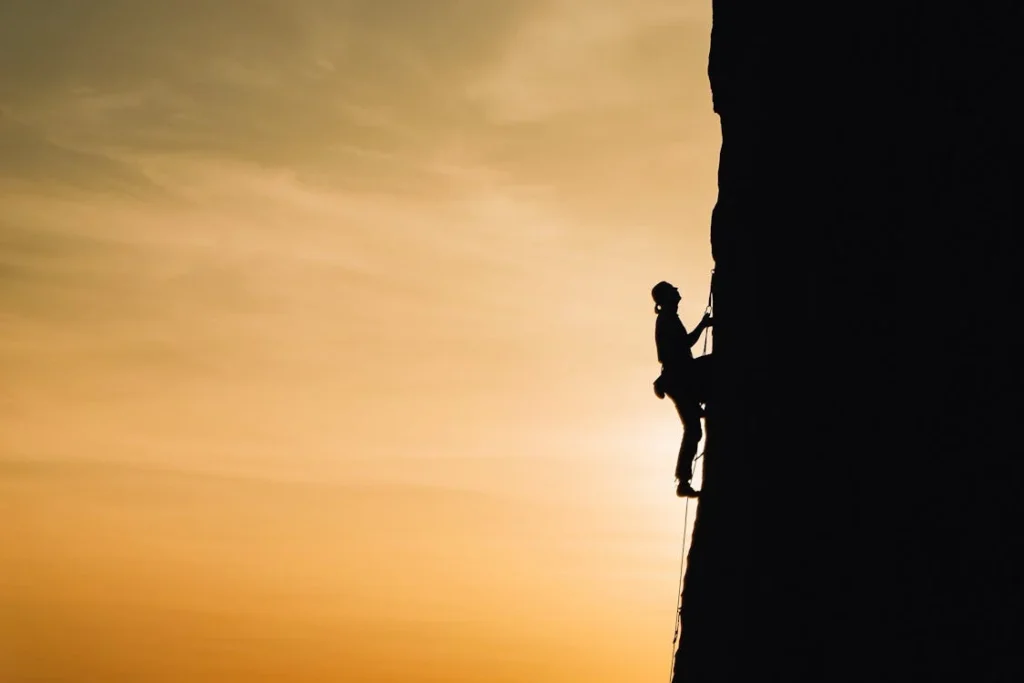Rock climbing has always been a sport that pushes human limits. It requires strength, balance, and strategy. But for amputees, climbing is more than just a challenge—it’s a way to reclaim freedom, build confidence, and prove that nothing is impossible.
Advancements in prosthetic technology are changing the game. Today’s climbing prosthetics are lightweight, strong, and built for performance. They help climbers grip, balance, and pull themselves up with precision. More amputees are joining the climbing community, breaking barriers, and reaching new heights—literally.
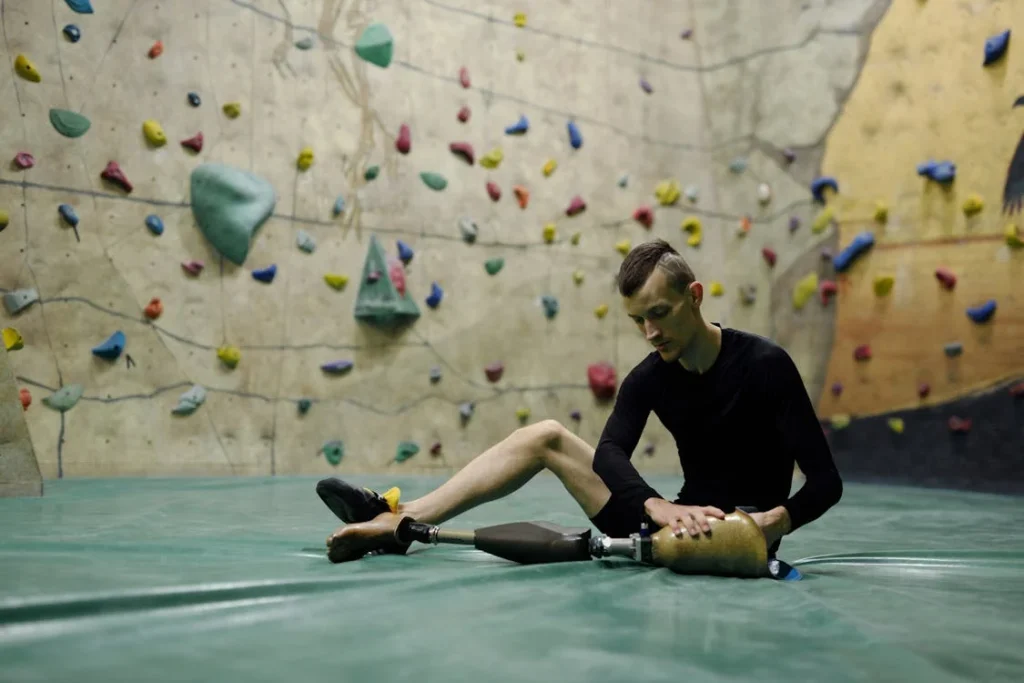
The Rise of Adaptive Climbing
Rock climbing has always been about problem-solving, endurance, and pushing limits. But for amputees, it represents something even greater—a way to reclaim their strength and prove that their abilities are limitless.
In recent years, adaptive climbing has gained recognition, with specialized prosthetics making it possible for amputees to scale walls, cliffs, and even some of the toughest outdoor routes.
Climbing gyms and outdoor climbing spots are becoming more inclusive, welcoming climbers of all abilities.
Organizations and events dedicated to adaptive climbing are growing, creating a strong community where amputees can train, learn from each other, and refine their techniques.
Climbers with limb differences are inspiring the world by showing that with the right mindset and the right technology, no summit is out of reach.
How Prosthetics Are Changing the Game
Traditional prosthetics were not built for sports like climbing. They were designed for walking, daily tasks, and mobility, but they lacked the strength, flexibility, and grip needed to scale a rock face.
Today, that has changed. Modern prosthetic limbs are designed specifically for climbing, giving amputees the ability to perform at high levels, just like any other climber.
One of the biggest innovations is specialized climbing feet and hands. For leg amputees, prosthetic feet with curved, rubberized edges allow for better balance and precision on footholds. Some even mimic the flexibility of an ankle, helping climbers shift their weight naturally.
Arm amputees use prosthetic hands with strong hooks or adaptive grips that can securely hold onto climbing holds, ropes, and cracks in rock surfaces. These attachments provide the necessary control and strength to pull the body upward, making steep climbs possible.
The material used in modern climbing prosthetics is also a game-changer. Lightweight carbon fiber and durable metals ensure that these limbs are strong yet agile.
Unlike older prosthetics that were heavy and difficult to maneuver, today’s climbing limbs are designed to enhance movement, not hinder it.
The fit is also more personalized than ever before. Each prosthetic is tailored to the climber’s unique needs, ensuring maximum comfort and functionality.
The Mental Strength Behind the Climb
Rock climbing is just as much a mental challenge as it is a physical one. Every climber, regardless of ability, faces fear, doubt, and exhaustion on their way up. For amputees, overcoming these mental barriers is just as important as finding the right prosthetic.
Many adaptive climbers talk about the fear of failure, especially when starting out. The thought of slipping, falling, or not being able to make a move can be intimidating.
But like any climber, they build confidence through practice. Each climb teaches problem-solving skills, patience, and resilience. Every successful ascent reinforces the belief that they are capable of overcoming challenges.
Community plays a huge role in this journey. Adaptive climbing groups and mentors provide support, encouragement, and advice. Training with others who have similar experiences can make the process less intimidating and more rewarding.
Many first-time amputee climbers find inspiration in those who have already mastered the sport, proving that determination and the right equipment make all the difference.
The Role of Rehabilitation in Climbing
Before amputees start climbing, rehabilitation plays a crucial role in preparing their bodies for the sport. Physical therapy helps strengthen muscles, improve flexibility, and enhance balance, all of which are critical for climbing.
Many climbers begin their training with basic exercises to develop core strength, coordination, and endurance.
Gamified rehabilitation has also made a significant impact. Programs designed to make physical therapy engaging and interactive help amputees regain movement faster.
Virtual reality climbing simulations and interactive strength-training exercises make the rehabilitation process more enjoyable and effective. These programs help build the necessary muscle memory and confidence before transitioning to real rock climbing.
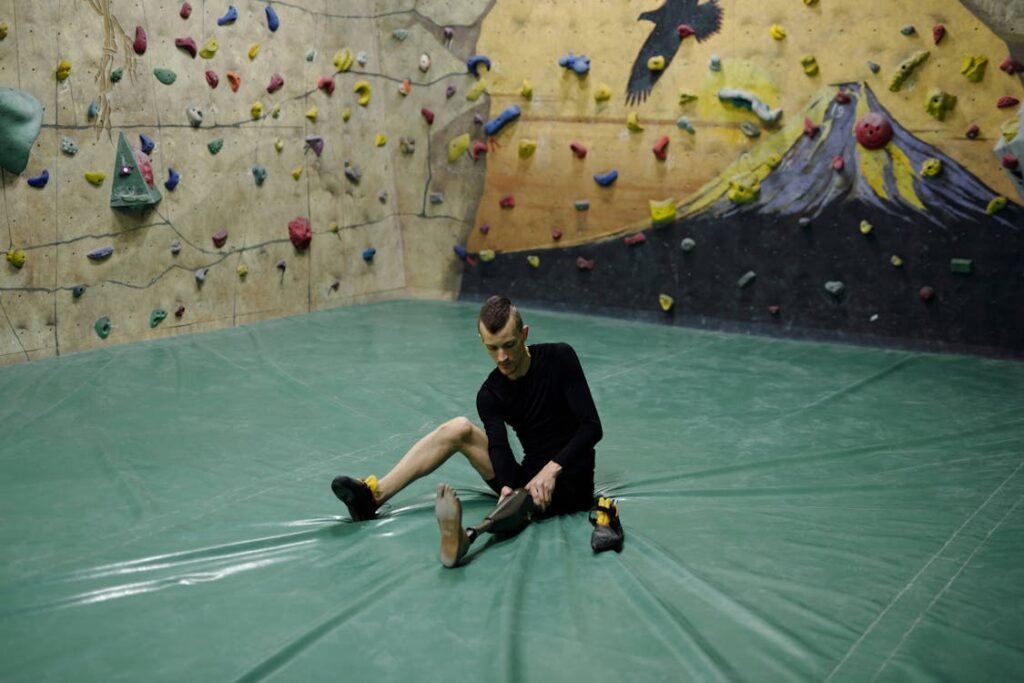
Real-Life Stories of Amputee Climbers
Stories of amputee climbers pushing boundaries and redefining possibilities are truly inspiring. These athletes prove that physical limitations do not define a person’s capabilities.
Many amputees take on rock climbing not just as a sport, but as a way to challenge themselves and break free from perceived limitations.
One such climber is Craig DeMartino, who lost his leg after a climbing accident. Instead of giving up, he adapted. With a specialized prosthetic foot designed for climbing, he returned to the sport and started competing at a high level.
His journey showcases the power of perseverance and how the right prosthetic can make a world of difference.
Another inspiring figure is Maureen Beck, a one-handed climber who has shattered stereotypes. Instead of seeing her limb difference as a disadvantage, she embraces it and climbs some of the most difficult routes.
She competes, mentors new climbers, and advocates for adaptive climbing programs worldwide. Her journey highlights that technique, strength, and strategy matter more than physical limitations.
These climbers and many others prove that climbing is a mental game as much as a physical one. Their determination, combined with advancements in prosthetic technology, has opened new possibilities for people who once thought climbing was out of reach.
Choosing the Right Prosthetic for Climbing
Selecting the right prosthetic limb for rock climbing depends on several factors, including the level of amputation, climbing style, and personal preference. There is no one-size-fits-all solution, but modern prosthetics offer a variety of features that cater to different needs.
For lower-limb amputees, specialized climbing feet provide better grip and flexibility. Some prosthetics mimic a natural foot’s movement, allowing climbers to balance on small footholds with precision.
Others are designed with a rigid structure for extra stability, especially on overhanging routes.
Upper-limb amputees have options such as hook attachments and adaptive grip systems. These tools allow climbers to hold onto rock edges, climbing holds, and ropes with a secure and reliable grip.
Some prosthetic arms are designed to lock into place at different angles, offering better control during climbing movements.
Comfort and adjustability are key factors in choosing a climbing prosthetic. Since climbing involves dynamic movements and weight shifts, a well-fitted prosthetic ensures maximum performance without causing strain or discomfort.
Many prosthetic companies now work closely with climbers to customize their limbs for specific climbing needs.
Training and Technique for Amputee Climbers
Rock climbing requires strength, balance, and problem-solving skills. For amputees, developing a strong technique is just as important as having the right prosthetic.
Core strength is essential for climbing. Since amputee climbers rely heavily on their upper body and core for movement, training these muscles helps with stability and endurance.
Many climbers incorporate exercises like planks, pull-ups, and resistance training to build strength.
Technique is another crucial factor. Adaptive climbers learn how to shift their weight efficiently and use their prosthetics strategically.
For leg amputees, understanding how to position the prosthetic foot on footholds makes a significant difference. Upper-limb amputees focus on using their remaining arm effectively while relying on prosthetic attachments for support.
Learning how to fall safely is also part of the training process. Falls are a natural part of climbing, and knowing how to land properly minimizes the risk of injury. Many amputee climbers practice controlled falls in climbing gyms before attempting more challenging routes outdoors.
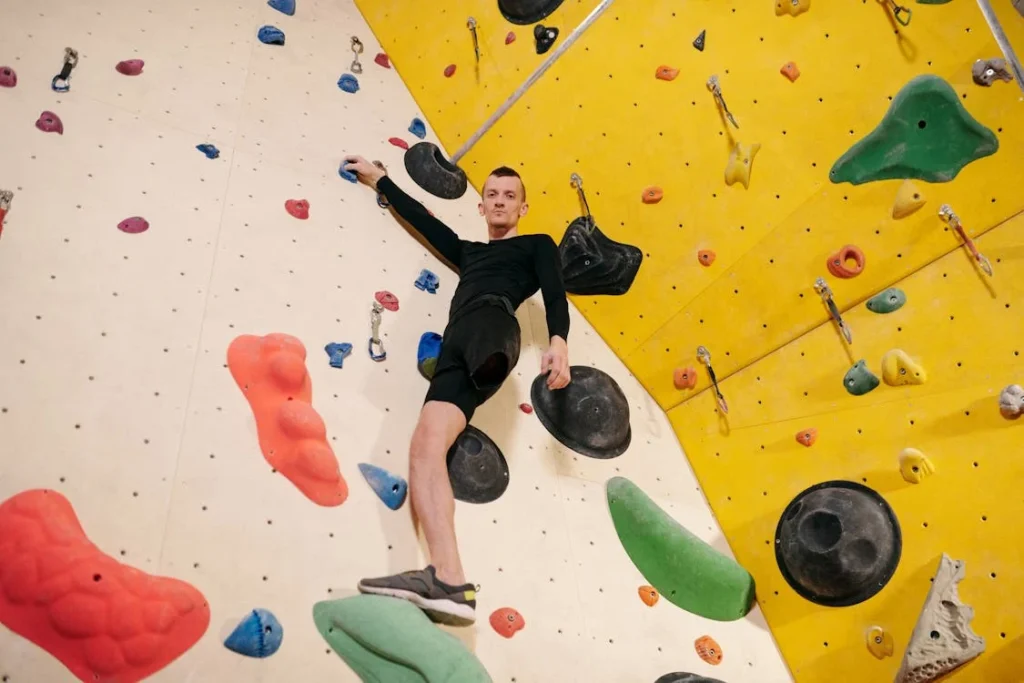
Overcoming Challenges in Adaptive Climbing
Every climber, regardless of ability, faces challenges on their journey. For amputees, the obstacles can be unique, but they are far from insurmountable. The right mindset, training, and support system can make all the difference in achieving climbing success.
One of the most common challenges is balance. With a missing limb, weight distribution changes, making certain movements feel unnatural at first.
Climbers must learn to adjust their center of gravity and rely on core strength to stay stable. Over time, they develop techniques that allow them to move fluidly, whether they are climbing indoors on artificial walls or tackling real rock formations.
Grip strength and endurance can also be a struggle, especially for upper-limb amputees. Holding onto small climbing holds for long periods requires strong fingers and forearms.
Some climbers use special training tools like grip trainers to build their hand strength, while others rely on prosthetic attachments that provide a secure hold. The more they train, the more confident they become in their ability to hang on and make progress up the wall.
Fear is another challenge that adaptive climbers must overcome. Climbing can be intimidating, especially when trying difficult routes for the first time.
Many amputees experience self-doubt, wondering if they can keep up with non-disabled climbers. But as they practice and push themselves, fear turns into confidence. Each climb becomes a victory, proving that they are just as capable as anyone else.
Climbing gear can also be a challenge. While prosthetics have come a long way, finding the perfect fit can take time. Some climbers go through multiple adjustments before finding a prosthetic that feels natural.
Working with prosthetists who understand the demands of climbing is crucial in getting the best possible fit. Once they have the right equipment, climbing becomes more comfortable and enjoyable.
The Role of Community and Support
Adaptive climbing is not a solo journey. The support of a strong community makes a huge difference. Amputee climbers benefit from joining adaptive climbing groups, where they can learn from others with similar experiences.
These groups offer mentorship, training sessions, and a sense of belonging that helps climbers stay motivated.
Climbing competitions and events for adaptive athletes are also growing. These gatherings provide a space for amputee climbers to showcase their skills, connect with others, and push themselves to new heights.
Competitions like the Paraclimbing World Championships bring together some of the best adaptive climbers in the world, proving that physical differences are no barrier to elite performance.
Family, friends, and coaches also play a key role. Having a support system that encourages and believes in the climber’s abilities can make a huge impact. Many climbers credit their success to the people who stood by them, offering motivation and guidance along the way.
The Future of Prosthetics in Rock Climbing
Technology is constantly improving, and the future of climbing prosthetics looks promising. Engineers and prosthetists are working on even more advanced designs that enhance performance and comfort.
Innovations in materials and biomechanics will make prosthetic limbs feel even more natural, helping climbers move with greater ease.
Some companies are experimenting with smart prosthetics that use sensors and artificial intelligence to adapt to a climber’s movement in real time. These innovations could revolutionize adaptive climbing, making prosthetic limbs even more responsive and effective.
The growth of adaptive sports is also driving demand for better prosthetics. As more amputees get into climbing, companies are investing in research to create specialized gear tailored for different climbing styles and levels.
This progress means that future climbers will have even more options to choose from, making the sport more accessible than ever.
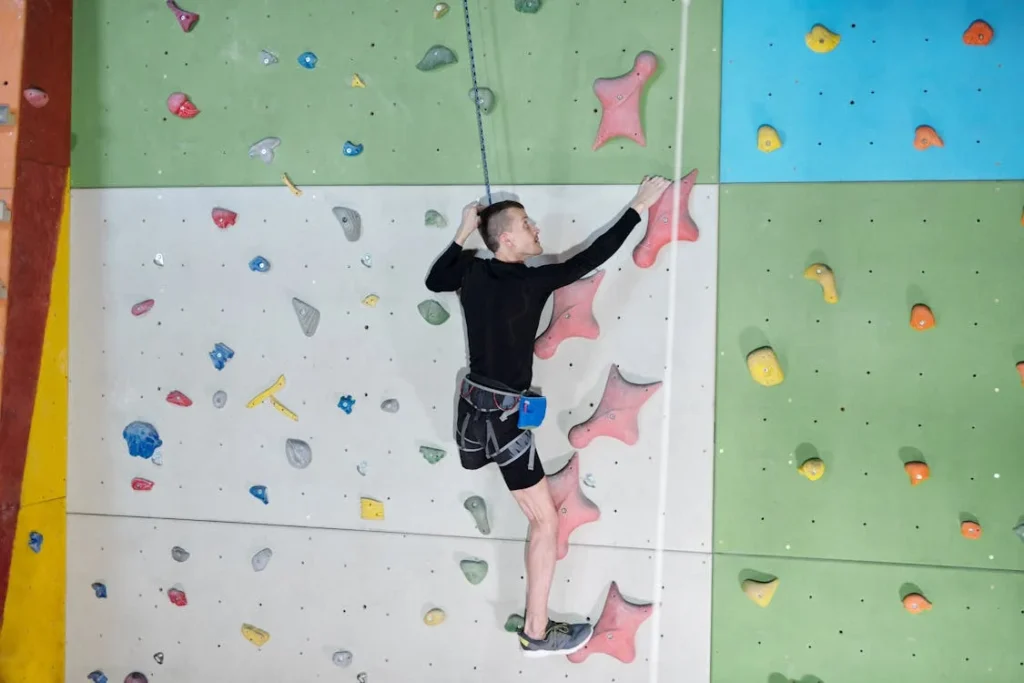
How to Get Started with Rock Climbing as an Amputee
For amputees who want to try rock climbing, the first step is believing that it’s possible. The sport is open to anyone willing to put in the effort, and with the right approach, progress comes quickly.
The best way to start is by finding an adaptive climbing program. Many climbing gyms now offer sessions specifically for people with disabilities, where trained instructors can help with technique, prosthetic adjustments, and confidence-building.
These programs provide a safe, controlled environment where beginners can learn at their own pace.
Choosing the right gym is important. A welcoming and inclusive space with knowledgeable staff makes a huge difference. Some gyms have specialized equipment, such as auto-belay systems or adaptive harnesses, to make climbing more accessible.
Asking about available accommodations before visiting can help ensure a smooth experience.
For those who prefer outdoor climbing, starting on easy, well-traveled routes with solid footholds is the best approach. Many outdoor climbing areas now have adaptive climbing days, where instructors and fellow climbers provide guidance and support.
Having a trusted climbing partner or mentor is invaluable, especially when navigating outdoor conditions for the first time.
Before hitting the wall, building basic strength and flexibility is crucial. Core workouts, grip training, and leg exercises help climbers gain control and endurance.
Simple exercises like planks, pull-ups, and squats make a big difference in overall climbing performance. Many climbers also practice movement drills on the ground to get used to shifting their weight and balancing with their prosthetics before attempting a climb.
Learning to Trust the Prosthetic
For new climbers, trusting a prosthetic limb takes time. Unlike natural limbs, prosthetics don’t provide the same sensory feedback, which can feel unsettling at first.
The key is repetition—using the prosthetic in different situations, learning its limits, and figuring out how to adapt movements accordingly.
Lower-limb amputees often start by practicing weight shifts and balance drills. Understanding how the prosthetic foot interacts with different types of footholds helps build confidence.
Many climbers find that using a prosthetic specifically designed for climbing makes a huge difference, as it provides better grip and stability.
Upper-limb amputees work on grip adjustments and arm positioning. Learning how to use a prosthetic hook or adaptive hand to maintain control on different types of holds is a process that improves with experience.
Over time, climbers develop a natural feel for their prosthetic, making movements smoother and more intuitive.
The Psychological Benefits of Climbing
Beyond the physical benefits, climbing is a powerful tool for mental and emotional growth. Many amputees describe the experience as transformative, helping them regain confidence and independence.
The sense of accomplishment after reaching the top of a route is unlike anything else—it proves that the body and mind are capable of extraordinary things.
Climbing also fosters resilience. Every climber faces falls, failures, and difficult moments, but learning to push through challenges builds mental toughness.
Many amputees apply the lessons they learn from climbing—patience, problem-solving, and perseverance—to other aspects of their lives.
The sport also creates a deep sense of community. Climbing is not just about reaching the top; it’s about the journey, the problem-solving, and the people who support each other along the way.
For amputees, finding a group that understands their challenges and celebrates their successes makes the experience even more rewarding.
Breaking Barriers and Changing Perceptions
The rise of adaptive climbing is not just transforming the lives of individual amputees—it’s changing how society views disability in sports.
More people are recognizing that physical limitations do not define what is possible. Amputee climbers are competing at high levels, gaining sponsorships, and showing the world that they belong in the climbing community.
As more climbing gyms embrace inclusivity and technology continues to advance, the future looks bright for amputee climbers. The barriers that once existed are being broken down, making way for a new generation of athletes who refuse to be limited by circumstance.
Rock climbing is not just a sport; it’s a statement. Every time an amputee reaches the top of a wall or a mountain, they prove that strength is not measured by limbs but by determination. With the right prosthetic, training, and mindset, the sky is truly the limit.
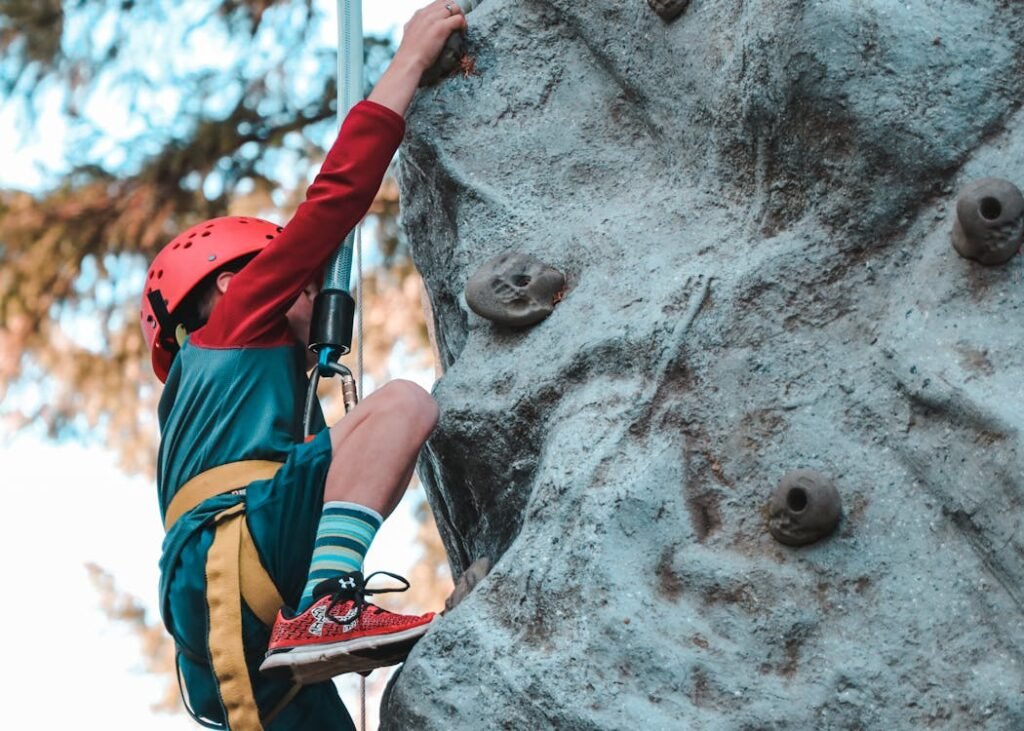
The Science Behind Climbing Prosthetics
The evolution of prosthetic technology has made rock climbing more accessible than ever for amputees.
But behind every successful climb, there is a combination of engineering, biomechanics, and material science working together to create prosthetic limbs that can handle the extreme demands of the sport.
Climbing prosthetics are not just about replacing a lost limb; they are about enhancing movement, stability, and control in ways that help climbers perform at their best.
Understanding Biomechanics in Climbing
Rock climbing is a highly dynamic sport that requires a deep understanding of body mechanics. Every movement involves a transfer of weight, engagement of different muscle groups, and precise coordination.
For an amputee climber, the absence of a limb changes how the body naturally moves. A well-designed prosthetic must compensate for this imbalance while allowing the climber to move as fluidly as possible.
Lower-limb amputees rely heavily on their prosthetic foot for balance and weight distribution. Traditional prosthetics are designed for walking, where the motion is predictable and repetitive.
Climbing, however, involves irregular movements, quick shifts in balance, and the need for strong push-offs from the foot. This is why specialized climbing prosthetics use materials that allow for a controlled level of flexibility, mimicking the natural movement of an ankle.
Some designs feature split-toe structures, which help climbers press onto small footholds with greater precision.
For upper-limb amputees, the biomechanics of grip strength and reach are critical. A human hand naturally adjusts its grip pressure based on the shape and texture of an object, but a prosthetic attachment must be designed to lock onto holds securely without slipping.
Many climbing-specific prosthetic arms use adaptive grip technology, which allows the attachment to conform to different rock features.
Some advanced designs even incorporate shock-absorbing materials to reduce strain on the rest of the body when hanging or making dynamic movements.
Materials That Make a Difference
The choice of materials in prosthetic design is just as important as the mechanics. Climbing prosthetics must be lightweight yet strong enough to handle the forces exerted during a climb.
Carbon fiber is a popular material due to its strength-to-weight ratio. It provides durability while keeping the prosthetic light, which is essential for maintaining balance and reducing fatigue.
Titanium is another material often used in prosthetics, especially for attachment joints and weight-bearing components.
It offers incredible strength without adding unnecessary bulk. In some designs, flexible polymers are integrated into prosthetic feet to allow a slight bend, mimicking how a natural foot would respond to pressure on a foothold.
Another key factor is the grip material. The surface of a climbing prosthetic must provide enough friction to stay secure on holds without slipping.
Some prosthetic hands and feet incorporate rubberized coatings similar to the rubber found on climbing shoes. This improves traction on both indoor climbing holds and natural rock surfaces.
The Role of Customization and Fit
One of the biggest challenges in designing effective climbing prosthetics is ensuring they fit the unique needs of each climber.
Unlike standard prosthetics, which follow general anatomical guidelines, climbing limbs must be customized based on the climber’s strength, movement style, and preferred type of climbing.
A climber who specializes in bouldering may need a prosthetic designed for explosive, powerful moves, while a climber focused on endurance routes may require a limb that prioritizes comfort and energy efficiency over long climbs.
The socket, which connects the prosthetic to the residual limb, is one of the most critical components. A poorly fitted socket can cause discomfort, instability, and even skin irritation.
Advances in 3D scanning and printing have made it easier to create personalized sockets that match the climber’s limb shape perfectly. This ensures a snug, secure fit that minimizes movement inside the prosthetic while maximizing comfort.
Adaptive climbers also have the option of interchangeable attachments. Some prosthetics allow climbers to switch between different grip types or foot shapes depending on the route they are climbing.
This level of adaptability gives amputees more control over how they approach each climb, making the experience more natural and efficient.
The combination of biomechanics, material science, and customization is what makes modern climbing prosthetics so effective.
As technology continues to advance, we can expect even more refined designs that offer greater mobility, better performance, and a closer replication of natural movement.
The science behind climbing prosthetics is not just about restoring function—it’s about enhancing it, pushing the boundaries of what the human body can achieve with the right support.
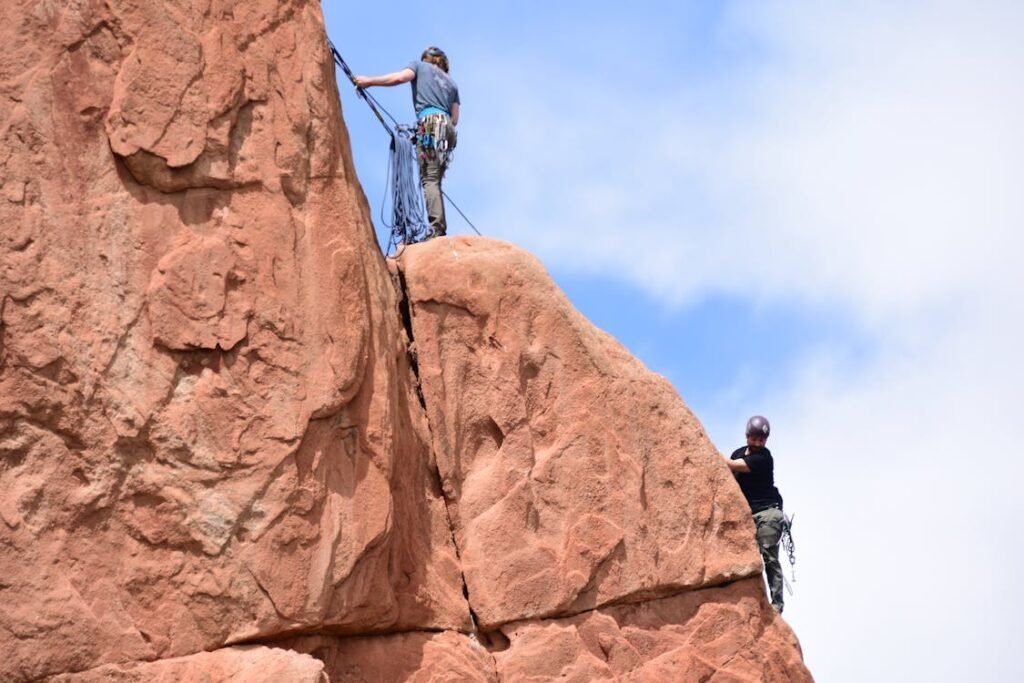
The Psychological Shift: How Climbing Transforms an Amputee’s Mindset
Rock climbing is more than just a physical challenge—it is a mental battle that forces climbers to confront fear, uncertainty, and self-imposed limitations.
For amputees, the journey into climbing is not just about adapting to a new sport but about shifting their entire perspective on what is possible.
The psychological impact of climbing goes far beyond the walls and cliffs, shaping how amputees approach everyday life with confidence and resilience.
Conquering Fear and Building Trust
Fear is a natural part of climbing, but for amputees, that fear can be amplified by the uncertainty of how their prosthetic will perform.
The idea of trusting a mechanical limb on a tiny foothold or using a prosthetic arm to hold body weight against gravity can be daunting. The first few climbs often come with hesitation, as the body and mind struggle to work together in unfamiliar ways.
Over time, however, something remarkable happens—amputee climbers begin to trust themselves and their equipment. With each successful movement, they learn that their prosthetic is not a limitation but an extension of their ability.
The fear that once held them back turns into motivation, pushing them to test their limits further. This shift in trust is not just about climbing; it extends to other aspects of life, helping amputees regain confidence in their independence and mobility.
Developing Problem-Solving Skills
Climbing is often compared to solving a puzzle. Each route presents a different set of challenges, requiring climbers to think critically about how to position their body, which holds to use, and how to maintain balance.
For amputees, this problem-solving process becomes even more intricate.
A missing limb means traditional climbing techniques may not always work. Amputees must experiment with different ways to approach holds, find alternative body positions, and adapt their movements to match their prosthetic’s capabilities.
This constant problem-solving strengthens cognitive flexibility, teaching climbers how to think quickly and creatively under pressure.
These skills translate into daily life. Many amputees report feeling more resourceful and adaptable after starting climbing.
The sport trains the brain to approach obstacles with curiosity rather than frustration, reinforcing the mindset that every problem has a solution—it just requires patience and persistence to find it.
The Emotional High of Reaching the Top
One of the most powerful moments in climbing is reaching the top of a route. For amputees, this experience carries even deeper meaning.
Every hold they grab and every move they make represents overcoming obstacles that once seemed impossible. The moment they pull themselves over the final ledge, the feeling of achievement is overwhelming.
This emotional high is not just about physical success—it is about proving to oneself that they are strong, capable, and in control.
It reinforces a sense of self-worth and accomplishment, which can be especially significant for those who have struggled with self-doubt after losing a limb.
Rewriting Personal Narratives
For many amputees, the loss of a limb comes with an identity shift. Some feel like they have lost a part of who they were, especially if they were active before amputation.
Climbing offers a powerful way to rewrite that narrative. Instead of seeing themselves as limited, amputees start to view themselves as athletes, adventurers, and risk-takers.
The community aspect of climbing also plays a huge role in reshaping identity. Climbing gyms and outdoor climbing groups foster a culture of inclusivity, where ability is measured by effort and determination rather than physical perfection.
Being surrounded by others who celebrate their achievements rather than focus on their differences helps amputees rebuild their confidence and self-image.
Climbing as a Tool for Mental Health
Beyond confidence and resilience, climbing has profound mental health benefits. The physical exertion releases endorphins, reducing stress and improving mood.
The focus required to climb forces climbers to be fully present, offering a form of mindfulness that can help alleviate anxiety and depression.
For many amputees, climbing becomes a form of therapy. It provides an outlet to release frustration, rebuild self-esteem, and reconnect with their bodies in a positive way.
The sport turns what was once a perceived weakness into a source of strength, proving that the mind is just as powerful as the body.
The psychological transformation that climbing brings is perhaps even more valuable than the physical progress. It teaches amputees that fear can be conquered, problems can be solved, and limits are meant to be pushed.
Through every climb, they are not just scaling walls—they are breaking through mental barriers and proving to themselves that they are capable of anything.
Conclusion
Rock climbing is more than a sport for amputees—it’s a journey of self-discovery, resilience, and empowerment. With advancements in prosthetic technology, the impossible is now possible, allowing climbers to push past physical and mental barriers. Adaptive climbing is not just changing how amputees engage with the sport; it’s transforming how they see themselves and their abilities.
Beyond the physical challenge, climbing offers a deep psychological shift. It builds confidence, problem-solving skills, and a mindset that embraces challenges rather than fears them. Every ascent is a reminder that limitations are often mental rather than physical.
As the climbing community grows more inclusive and prosthetic innovations continue to advance, the future is bright for amputee climbers. They are proving that strength is not about having all your limbs—it’s about determination, creativity, and the courage to keep reaching higher.
Whether you’re an amputee considering climbing for the first time or someone inspired by these incredible athletes, one truth remains: the only limits that exist are the ones you refuse to challenge. Keep climbing, keep pushing, and never stop believing in what’s possible.



